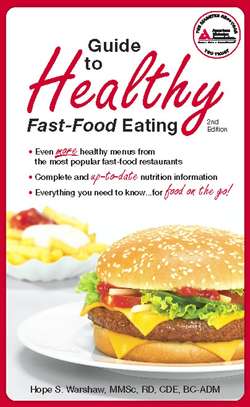Читать книгу Guide to Healthy Fast-Food Eating - Hope S. Warshaw - Страница 8
ОглавлениеRestaurant Pitfalls and Strategies for Self-Defense
Eating out healthfully is no easy task. It’s downright challenging! You need willpower and perseverance. It’s tough enough to eat healthfully in your own house, but even more challenges confront you when you are not able to control the portions or the condiments. You can’t march into a restaurant’s kitchen and hold the cook’s hand while they ladle on more butter, slather on more mayonnaise, or shake more salt onto your once healthy foods.
Healthy restaurant eating is a challenge because of numerous pitfalls—from huge portions to the use of large quantities of fats, oils, sugar, and salt. Don’t despair. You can learn to choose to eat healthfully in 99% of restaurants. To help make it easier on you, it’s important to learn the pitfalls of restaurant eating. You’ll find these discussed below. Next, you’ll want to become well versed on healthy eating strategies. As you thumb though the tips and tactics in the pages ahead, you’ll note that these strategies emerge repeatedly.
Pitfalls of Restaurant Eating
You think of restaurant ventures as special occasions. Yes, once upon a time, people only ate in restaurants to celebrate a birthday, Mother’s Day, or an anniversary. Not today. According to the latest statistics from the National Restaurant Association, the average American eats six meals away from home each week. And you may easily top that number. When you eat that many meals away from home, your waistline can quickly spread if you treat each meal as a special occasion. So, do you give up restaurant foods? There’s no need to take that drastic step. Plus, depending on your schedule, cutting out eating out may not be possible for you. Today, restaurant meals for most people are just part of your fast-paced life and no longer just special occasions.
You’re not the cook. Your methods to control both portions and how your food is prepared are to ask questions about the food on the menu, to make special requests to get an item delivered the way you want it, and to practice portion control when you order and when you eat. Yes, assertiveness will be required!
Fats are here, there, and everywhere. Remember, fat makes food taste good and stay moist. Restaurants love it. Fat is in high-fat ingredients, such as butter, sour cream, or cream; in high-fat foods, such as cheese, bacon, or potato chips; and in high-fat cooking methods, such as deep-fat frying, breading and frying, and sautéing. It’s also at the table in the form of fried Chinese noodles, tortilla chips, or butter or oil for breads. You need to master the craft of being a fat sleuth. You’ll get plenty of tips ahead.
Sodium can skyrocket. Along with fat, salt makes food taste good. Salt or high-sodium preservatives are also used in many pre-prepared restaurant foods to keep them safe. Sodium can be particularly high in fast-food restaurants and others that use pre-packaged foods. It’s nearly impossible for you to cut the sodium count of pre-packaged foods. The sodium can also be high in restaurants that prepare food from scratch, simply because they maximize taste by lathering the food in salt. Some ethnic foods, particularly Asian cuisines, can be high in sodium because of seasonings and sauces, like soy and teriyaki sauce. If you’re watching your sodium intake, you will need to learn the ingredients and preparation methods that boost sodium and know where and how you can make reasonable special requests.
Portions are oversized. Restaurants simply serve too much food. Unfortunately, we’ve evolved to a value = volume proposition in restaurants. Portions of food, particularly those produced and provided inexpensively, such as chips, fries, and drinks, are often enough for two. If there’s one place to focus your attention and slowly change your behaviors, it’s to develop and implement strategies that help you to not overeat. Hopefully you have a few willing dining partners in your midst.
Meat (protein) is front and center. A primary focus of the American diner is summed up in the catchphrase “Where’s the beef?” Whether it is fish, chicken, or beef, the “meat” or main source of protein often takes center stage, particularly in restaurant meals. For example, a portion of red meat in table service restaurants is often 8 oz or more cooked. (It’s easier to order just-right portions of meats in fast-food restaurants by sticking with those small portions.) A chicken breast is often a whole chicken breast. A goal to eat healthier is to think about moving meat from front and center to the side where the portion takes up only one-quarter of your plate. Fill about half of the rest of your plate with vegetables and the other quarter with whole-grain starches. Yes, a goal to strive for, but not easy to do with restaurant meals!
